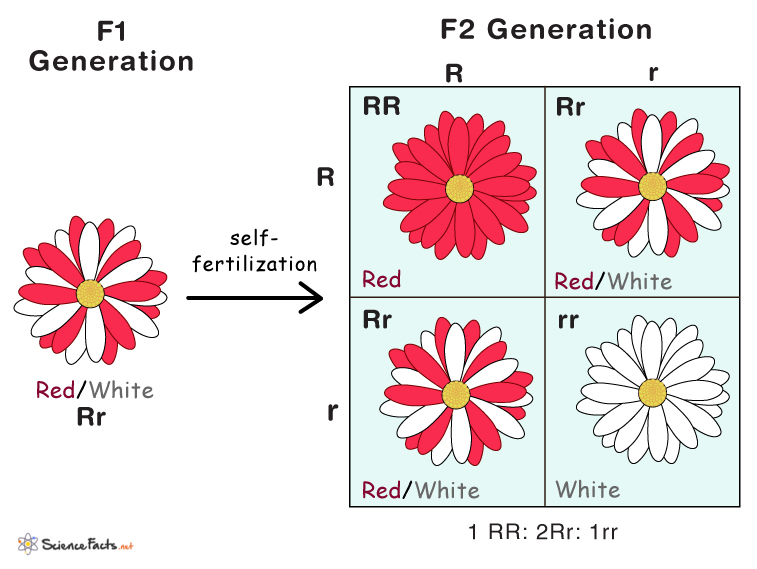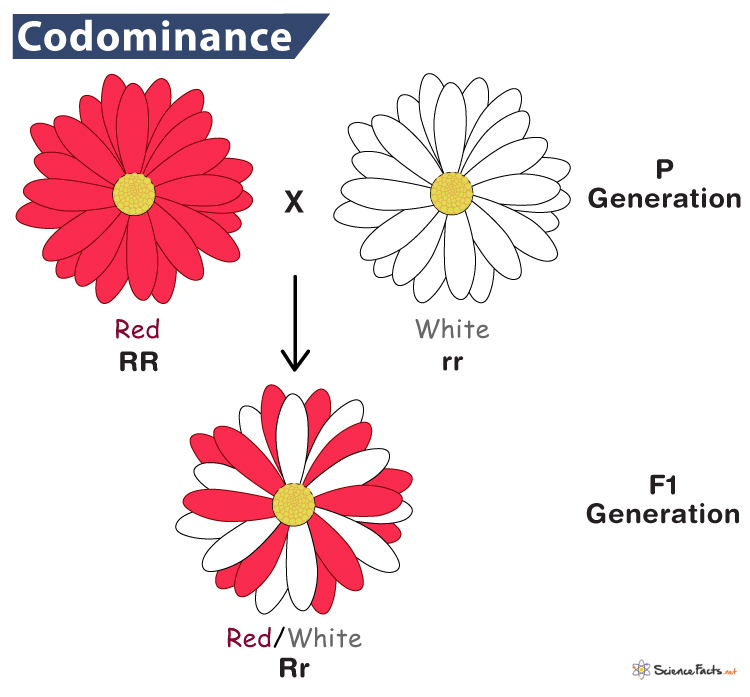Codominance
Codominance is a form of inheritance where two alleles of the same gene are expressed roughly equal amounts in an organism. Thus, when alleles for a trait are codominant, both phenotypes are simultaneously displayed. Since it does not follow Mendel’s inheritance law, it is called a Non-Mendelian inheritance.
It is commonly found in plants and animals having more than one pigment color. For example, if we cross a red and white flower with a codominant pattern, the offspring flower will have red and white patches. This type of relationship between alleles is called codominance.
How Does Codominance Work
A red flower RR with two dominant red alleles is crossed with a true breeding (homozygous) white flower rr having two recessive alleles corresponding to the red color. All F1 offspring are heterozygous Rr, displaying red and white codominant phenotypes.
Self-pollination of the codominant F1 plants produces offspring with phenotype 1 red: 2 red/white: 1 white. Thus, alleles are still inherited according to Mendel’s laws, even when they show codominance.
Codominance Punnett Square
To understand the mechanism of codominance and verify if it follows Mendel’s laws of inheritance, the botanists use Punnett square as shown below:

The result thus shows codominance in 100% of F1 offspring and 50% of F2 offspring.
Other Examples of Codominance
MN Blood Grouping in Humans
It is the most common example of codominance in MN blood groups of humans. A person’s MN blood type is determined by two alleles, M and N, of a particular gene. An LM allele has an M marker on the surface of the red blood cells (RBCs), while an LN allele has an N marker.
Individuals homozygous for the M allele have M as the RBC antigen. Similarly, organisms homozygous for the N allele have N as the RBC antigen. Heterozygotes (LM LN) have both types of markers expressed equally on the surface of the RBCs.
ABO Blood Grouping in Humans
Persons with type AB blood have one allele for A and the other for B that are dominant. In contrast, the O allele is recessive, and thus its expression is masked by the expression of the other alleles.
The altered hemoglobin that causes sickle-celled anemia is inherited as a codominant trait. Heterozygous individuals express normal and sickle hemoglobin, so they have a mixture of normal and sickle red blood cells.
Codominance in Other Animals
- Speckled chickens have alleles for both black and white features.
- Roan cattle have alleles for both red hair and white hair.
Codominance in Plants
- Rhododendrons express red and white color flower petals simultaneously.
Codominance vs. Incomplete Dominance
Codominance and incomplete dominance are two genetic inheritance patterns found in living beings where one allele is not completely dominant over the other allele.
What is the Difference between Codominance and Incomplete Dominance
In codominance, both parental phenotypes are expressed together in the offspring. In contrast, in incomplete dominance, the two parental phenotypes blend to form a new phenotype for their offspring. Some other common differences are:
| Basis | Codominance | Incomplete Dominance |
|---|---|---|
| 1. Type of Dominance | Neither of the two alleles is dominant | One allele is completely dominant over the other |
| 2. Phenotype | Both the allele colors blend equally in the offspring | Both allele colors blend, but one of them is expressed |
| 3. Hybrid Phenotype | A hybrid does not give rise to a new phenotype | A hybrid always gives rise to a new phenotype |
| 4. Examples | MN blood grouping in humansABO blood grouping in humansRoan nature in cattle | Pink flowers snapdragon, Antirrhinum majus, formed when a homozygous red flower is crossed with a homozygous white flower.The inheritance pattern of height, weight, and eye color in animals, especially humans |
| 5. Qualitative/Quantitative Approach | It is a qualitative approach to the gene expression | It is a quantitative approach of both of the alleles of a gene |
-
References
Article was last reviewed on Friday, November 18, 2022




